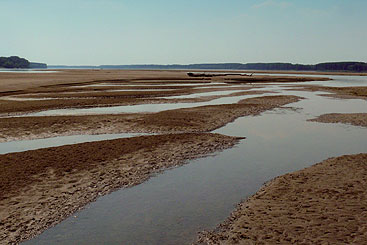New life for the Great Marsh

New life for the Great Marsh
For the first time in decades, the marshes of the ‘Kalimok Brushlen’ protected area are returning unspoilt nature of the floodplains along the Danube in Bulgaria, due to the efforts of the largest wetlands restoration project in Bulgaria.

The Sands of Radetzki Island are part of a new protected area of approximately 6,000 hectares called ‘Kalimok Brushlen’. This protected site covers the eastern part of the Great Marsh as well as the adjacent section of the Danube River (km 434 to km 461) and eight islands.
In the past, the largest lowland floodplain of the Danube River in Bulgaria was known as the Great Marsh. It attracted people from around the region, offering protection against enemies and abundant food – evidence of fishing in the floodplain goes back some 6000 years. Over the centuries, fishing has remained the main livelihood of the region, and local fishermen are known as the best on the Danube River.
Up to the 1940s, the Great Marsh was under the care
of a local fishermen’s association. The mouth of the
swamp where it connects with the Danube was cleaned
every autumn to be ready for fish spawning. The marsh
was rich – catches of carp alone amounted to 600
tonnes per season. But in 1948 the new government
in Bulgaria decided to dry all the marshes around the
Danube and turn them into fields.
Rebuilding the Great Marsh. In 1980 the construction of the largest fishponds in Bulgaria began. While production of fish never came close to the amount of fish caught in the swamp, fishponds served a positive purpose. Nature around them began to recover in full force, reminiscent of its former brilliance. From this moment on, environmentalists in Bulgaria have strived to preserve this territory.
Early in the 21st century, the Bulgarian government launched the largest nature conservation project ‘Restoration of wetlands and reduce pollution of the Danube River’ to meet the commitments of the Green Corridor – Lower Danube (see article page 26). The first step in 2001 was to announce a new protected area of about 6,000 hectares called ‘Kalimok Brushlen’. This protected site covers the eastern part of the Great Marsh as well as the adjacent section of the Danube River (km 434 to km 461) and eight islands. Some 1750 ha have been revitalised by restoration activities, including three locks at the Danube dike to reconnect the restored marsh with the Danube River and the removal of fishpond dikes to ensure water movement throughout the territory. The restoration measures have been accompanied by the construction of a new dike and a drainage channel around the restored zone to protect agricultural land around the marsh.
Flooding returns. As a result of the restoration efforts, for the first time in decades the Kalimok-Brushlen marshes were flooded again during the high water period in 2009. The whole territory has changed into a huge wetland offering perfect conditions for characteristic species like Spoonbill, Glossy Ibis and Whiskered Tern to breed again in large numbers.
Due to its international importance for nature protection, the Kalimok-Brushlen Protected Site has been declared internationally as an Important Bird Area. Since 2009, it has been a partner of DANUBEPARKS – the Danube River Network of Protected Areas. This initiative is funded by the EU in the European Territorial Cooperation South-eastern Europe programme to develop a platform for continuous cooperation of protected areas and establish a habitat network with the Kalimok-Brushlen as a cornerstone.





